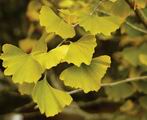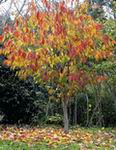Susie Longdell and Jude Gillies explore the mysteries of the blaze of reds, oranges and yellows that herald autumns.
Is your garden missing out when it comes to autumn’s spectacular seasonal show or does it put on a half-hearted performance?
At other times of the year, plant shapes, growth habits, textures and flowers may command attention but at this time of the year it is the glorious display of autumn leaves that makes our garden landscapes memorable.
 This is especially so the further south you go. Southerners may sigh when reading about the spectacular sub-tropicals in summer but can feel smug as autumn advances. Its fiery fiestas are so much easier to stage in cooler climes. But with a little planning, even warmer gardeners can exploit some of deciduous plants’ colourful, all-out performance before they retire for winter. Just a single small-tree specimen, like the deservedly popular Cercis ‘Forest Pansy’ set against dark green foliage or a blue (or grey) sky, will mount a memorable show.
This is especially so the further south you go. Southerners may sigh when reading about the spectacular sub-tropicals in summer but can feel smug as autumn advances. Its fiery fiestas are so much easier to stage in cooler climes. But with a little planning, even warmer gardeners can exploit some of deciduous plants’ colourful, all-out performance before they retire for winter. Just a single small-tree specimen, like the deservedly popular Cercis ‘Forest Pansy’ set against dark green foliage or a blue (or grey) sky, will mount a memorable show.
If you are new to gardening, don’t spurn a deciduous tree like this because it drops its leaves. Evergreen trees also shed leaves. The only difference is that deciduous plants shed theirs over a short period, while evergreens typically lose theirs much more slowly over longer periods.
Deciduous trees and shrubs drop their leaves all at once in autumn because it is the means they have developed to survive the cool or cold winters in their homelands. Thus, they avoid foliage damage from frost and winter wind and drastically reduce plant processes while it is cold and there’s insufficient sunlight for the photosynthesis that produces sugar that is their fuel. Leaf loss also cuts transpiration of water from leaves when replacement moisture can be locked up in snow or frozen soil. The fiery autumn performance many deciduous trees produce as part of the leaf fall process is a bonus for gardeners.
 Many trees we grow in New Zealand, such as poplar and birch, originate in climates much colder than our own. They need a long autumn with warm days and chilly nights to colour well. The common liquidambar, on the other hand, comes from the east and southern United States where the weather is milder and similar to parts of New Zealand. As a result, liquidambars are more reliable autumn performers in warmer parts of New Zealand. Similarly, other trees from warmer regions, such as the golden rain tree (Koelreuteria paniculata), will also give a more reliable show colour in northern parts of the country.
Many trees we grow in New Zealand, such as poplar and birch, originate in climates much colder than our own. They need a long autumn with warm days and chilly nights to colour well. The common liquidambar, on the other hand, comes from the east and southern United States where the weather is milder and similar to parts of New Zealand. As a result, liquidambars are more reliable autumn performers in warmer parts of New Zealand. Similarly, other trees from warmer regions, such as the golden rain tree (Koelreuteria paniculata), will also give a more reliable show colour in northern parts of the country.
Then there are the trees that put on an autumn performance as a bonus. The persimmon, an ideal tree for the home garden, gives reliably good autumn colour as well as its delicious fruit. Many of the flowering cherries follow up their spring blossom displays with good autumn colour, even in warmer regions. Another such repeat performer is the spring-flowering Japanese snowdrop tree (Styrax japonica).
Copyright © Weekend Gardener: www.weekendgardener.co.nz
For subscriptions and further infomation please go to the Weekend Gardener website.











Join the Discussion
Type out your comment here:
You must be logged in to post a comment.